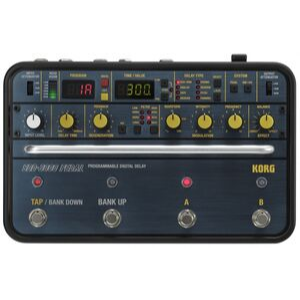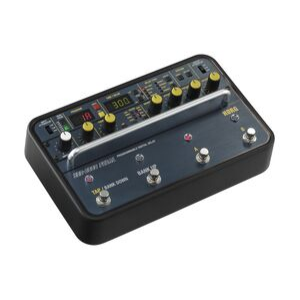- Home
- Instruments
- Gear
- Recording
- Lessons
- Reviews
- Blog


| Controls: |  |
| Features: |  |
| Performance: |  |
| Value: |  |
Korg's SDD 3000 digital delay unit first burst onto the scene in 1982 with almost instant success. Guitar icons like The Edge swore by it, making it a must-have for future guitar heroes. The Korg SDD 3000 pedal is now back in production by popular demand, this time in a new form. Can it compete with the best delay pedals around? Let's take a look.
 Features
FeaturesThis isn't just a replica of the old SDD 3000 housed in a pedal, it's much more. Along with the original voicing, this new updated version offers a further seven delay types. The new delay types include analog, tape modern, Kosmic, pitch, panning, and reverse.
Five modulation waveforms are available; one morphs seamlessly into the next as you turn the selection knob. A cool feature here is the introduction of the LCR button. The LCR button lets you select delays that bounce left, right, and center, rather than just left to right. This mode also lets you set independent feedback times for left, right, and center for precision control. You can save a huge 80 programs (more than you are likely to need), which are split into two banks of 40.

Coming from a rack-mounted unit to a foot pedal gave us some concerns over the layout of the new SDD 3000. Fortunately, any concerns were quickly put to rest upon sight of the new unit. Despite having so many selectable delay types and waveforms, the front panel is clear and concise. On top, you have your input attenuator switch and visual displays. The displays are your headroom gauge, program display, and delay time display – all are nice and clear. Next, you have your delay type selector, LCR button, and output attenuator.
In the middle, you'll find input level, delay time, and feedback knobs, pretty straight forward. A three-stage low/high filter section is controlled by two simple buttons. Rounding up the mid-section is the waveform selector, intensity/modulation, frequency, and balance knobs — again, all pretty straight forward.
All that's left are the footswitches; the first two are for switching between program banks, and the second two switch between channels.
The SDD 3000 ticks all of the boxes when it comes to stage or studio use. Korg's original SDD 3000 sound remains as powerful as it always was; its warmth and smoothness while maintaining clarity make it more musical than most competitors. The new features are easy to maneuver, and the displays give great visual feedback to keep you on track.
The ability to choose your waveform shape lets you be more experimental without losing control. If you do feel the need to be even more precise, you can plug in an external expression pedal. Overall, it delivers iconic performance that you don't need to be an expert to use.
The question is this; is it better than the original? Our answer would be yes, it is. Nothing is lost when going from a rack-mounted unit to a pedal; the quality is the same. The difference is you have more features, better features, and easier control while performing.
If there's any downside, it could be that it's a little pricey for a delay pedal. We would guess that if you do buy it, you won't regret the investment one bit. A stellar job by Korg to bring another classic back to life.
For more info about the Korg SDD 3000 delay pedal, click here.
For more delay pedals, click here.

Reader Interactions